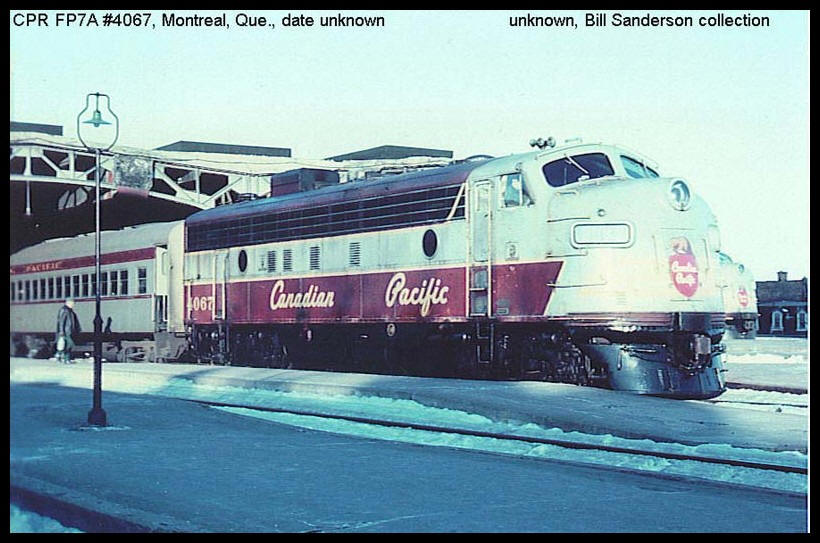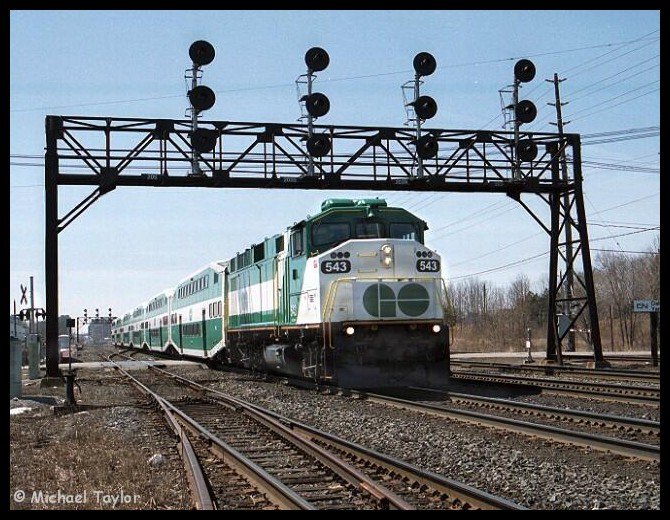AMT COMMUTER - GO TRANSIT
AMT - Agence Metropolitaine de TransportAMT news editor Jean-Francois Turcotte:amtnews@canadianrailwayobservations.com Winter arrived late in Montreal, with our first storm January 12th. Michael Berry braved the elements and clicked a westbound AMT train making its station stop on its way to Vaudreuil, with AMT GP40FH-2 4143 (leased from NJ Transit) leading, and AMT F40PHR 400 pushing. A bit later, a deadhead train heading to Lucien L'allier station (in downtown Montreal) passed by with RBRX F59PH 18531 leading.
AMT ALP45DP Watch (11 units on the property)
AMT 1350 In storage following testing. AMT 1351 Arrived in Port of New Jersey Jan 12th.. AMT 1352 Removed from service following derailment. AMT 1353 In storage following testing. AMT 1354 In storage following testing. AMT 1355 In storage following testing. AMT 1356 Stored in Ste-Eustasche since early Jan.
Stored in Ste-Eustasche since early Jan. AMT 1360 Although unconfirmed by official sources, recent testing has revealed that the powerful ALP45DP exert forces on the rail that are considerably higher than those from a standard locomotive, especially in electric mode. This factor may (or may not) have contributed to the derailment of unit 1352 at Central Station in December 2011, and the subsequent withdrawal of all the ALP45DP’s, because the engine was in diesel mode. Daniel Leduc photographed AMT ALP45DP 1351 at Newark, NJ January 11th, the first locomotive to arrive with AMT numbers under the cab windows.
“Train de l’Est on the Wrong Track”, President Quebec’s Ministry of Transportation (MTQ) severely criticized AMT’s management of the Train de l’Est project. The cost of this commuter rail line to Repentigny and Mascouche, initially budgeted at $300 million, has ballooned to $715 million, for a projected ridership of only 11000 daily riders. By comparison, extension of the orange Métro line to Laval in 2006 costed $745 million and has added 60000 daily riders. While vowing to complete the project, MTQ has forced AMT to scale-back some of its aspects, aiming to save up to $54 million including: Cancellation of the projected station in Charlemagne (it was to be located at the junction of highways 640 and 344); Reduction in parking spaces at some stations; Reduced passenger amenities at Mascouche. However, most of the work is already completed or under way, leaving little room for cost reduction. Some observers fear that reducing parking space may undermine the line’s already low projected ridership, finally resulting in a higher cost per passenger. The MTQ is also strongly advocating improved security features in the Mount Royal tunnel as a condition for letting diesel-laden ALP45DP’s run through. This alone may cost up to $200 million (in addition to the afore-mentioned $715 million for the Train de l’Est itself), and may push the line’s introduction up to 2014. The lack of safety features of the tunnel had been drawing up much fire lately. As a casualty of those major controversies, AMT’s President Joël Gauthier resigned on Friday January the 13th 2012. A persistent rumor has current STM General Manager Yves Devin stepping-in to fill the void. Montreal Commuter Vignette The late afternoon winter sun is already starting to set as CPR FP7 4067 prepares to depart Windsor Station in the early 1970’s with a Commuter train bound for the West Island. At this time, CPR had begun repainting many of their Tuscan red cars into this silver and red scheme. CP Rail Action red was soon to follow!
CPR Steam & Passenger Vignettes (courtesy Ray Kennedy’s “Old Time Trains” website ) Check out these terrific photos of CPR steam at Windsor Station, Glen Yard, Westmount Station and at Montreal West.
GO TRANSIT Edited by Daniel Dell’Unto The Kitchener line GO train consists initially ran as L10L's, that is, with a locomotive at each end (typically an F59 at the west end and and MP40 at the east). GO has operated L10L's on other lines to combat wheel-slip problems caused by leaves on the track. This practice has ended in early January as the Kitchener GO trains reverted back to the typical L10 consist with only one locomotive. On January 28th GO will begin stopping at the new Allandale Waterfront GO Station in downtown Barrie, with GO Buses begin serving the new station the same day. GO Trains making it the last stop on the Barrie line starting January 30th. The new stop will be equipped with 12-car rail platforms, heated shelters, a pedestrian tunnel to access the north and southbound platforms, a 6-bay bus platform, passenger pick-up area, bike parking, and about 150 parking spaces.
Back in April of 2008, two trains of Bombardier T1 subway cars were involved in an accident in Wilson Yard. Two of the cars that collided, 5185 and 5326, sustained the most damage, with the front end of the carbody of 5185 bent down. Four cars involved (5185 and 5326 plus their mates 5184 & 5327) were shipped to Bombardier's Thunder Bay manufacturing plant for evaluation and possible repair work. Two cars, 5185 and 5326, were deemed to have sustained too much damage to repair and have been retired. The remaining two cars, 5184 and 5327 were shipped back in late 2011 and mated together, with the TTC renumbering 5327 to 5185(:2, the second). They were noted back in service by mid-January 2012. The latest TTC roster included in the Service Summary listed 34 H4 subway cars, the oldest in service (Hawker Siddeley, 1973) still in active service as of early December 2011. But, annual winter service reductions taking effect December 16th, and more and more T1's being transferred over to the Bloor-Danforth as new Toronto Rocket trainsets come online had caused most of the H4's to be parked. When service resumed to prior levels on January 9th, a number of transit enthusiasts have spotted a few H4 trains back in service, still running after nearly 40 years on the roster. It is unknown exactly when the final few will retire for good.
For more info about the TTC's different subway cars, click HERE © CRO February 2012 |



